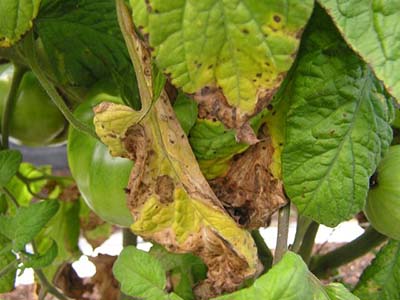Plant Diseases
What's wrong with my plant? Is it a disease?

Leaf blight (caused by a fungus) damage on tomato leaves. UF/IFAS.
Many organisms, including viruses, fungi, and bacteria, can cause diseases in plants. Diseases can be specific to certain plants, but identifying them can still be extremely difficult.
Often, home gardeners mistake environmental or maintenance problems for diseases. For example, Spanish moss, lichens, and ball moss are not parasites that should be killed or removed; they are merely harmless plants themselves.
Another common misdiagnosis in coastal areas is mistaking saltwater damage for disease. Irrigating plants with salty well water can cause yellowing around the edges of leaves and leaf-drop starting from the bottom part of the plant's canopy.
When a plant does have a disease, the problem may be merely cosmetic rather than truly damaging to the plant. Examples are minor leaf spots or other damage to select leaves. Such minor aesthetic concerns are no cause for alarm or treatment.
There are serious diseases, however, that can damage or kill plants they affect. Examples are mushroom root rot on landscape plants, lethal bronzing disease in palms, and take-all root rot on turf. Such diseases can seriously damage the plant's appearance or growth.
Because diseases are difficult to identify, do not assume a disease is in the works just because of a plant's appearance. Use a magnifying glass to look for insect pests that may be causing the damage. Also analyze maintenance practices for causes related to visible symptoms. If you still suspect a disease, contact your county Extension office for advice on how to collect and submit plant samples for disease diagnosis and recommendations on the least toxic methods of treatment.
Diseases
- Armillaria Root Rot
- Bacteria and Plant Disease
- Black Spot vs. Cercospora Leaf Spot on Roses
- Camellia Pests and Problems
- Citrus Greening: Frequently Asked Questions
- Fungi and Plant Disease
- Large Patch in Florida Lawns
- Lawn Diseases
- Lethal Bronzing Disease (LBD)
- Powdery Mildew
- Powdery Mildew vs Downy Mildew
- Rose Rosette Virus
- Sugarcane Mosiac Virus in Florida Turfgrass
- Viruses and Plant Disease

